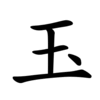玉
| ||||||||
Translingual
| Stroke order | |||
|---|---|---|---|
| Stroke order | |||
|---|---|---|---|
 | |||
| Stroke order (Japan) | |||
|---|---|---|---|
 | |||
Alternative forms
- 𤣩 (When used as a radical component)
Han character
玉 (radical 96, 玉+0, 5 strokes, cangjie input 一土戈 (MGI), four-corner 10103, composition ⿱一圡 or ⿷王丶)
- Kangxi radical #96, ⽟.
- Shuōwén Jiězì radical №6
References
- KangXi: page 726, character 4
- Dai Kanwa Jiten: character 20821
- Dae Jaweon: page 1135, character 6
- Hanyu Da Zidian: volume 2, page 1100, character 1
- Unihan data for U+7389
Chinese
| simp. and trad. |
玉 | |
|---|---|---|
| variant forms | 𤣩 𠀛 | |
Glyph origin
| Historical forms of the character 玉 | ||
|---|---|---|
| Shang | Western Zhou | Shuowen Jiezi (compiled in Han) |
| Oracle bone script | Bronze inscriptions | Small seal script |
 |
 |
 |
| Characters in the same phonetic series (玉) (Zhengzhang, 2003) | |
|---|---|
| Old Chinese | |
| 珏 | *kŋroːɡ |
| 砡 | *ŋuɡ |
| 匤 | *kʰoɡ |
| 玉 | *ŋoɡ |
| 鳿 | *ŋoɡ |
| 頊 | *ŋoɡ, *hŋoɡ |
The character's shape was historically very similar to 王; a dot was introduced to differentiate the two.
Pictogram (象形) : a picture of a cong (琮), a sort of ritual jade totem.
It is also interpreted as three pieces of jade strung together on a string.
Pronunciation
Definitions
玉
Compounds
Derived terms from 玉
|
|
|
Japanese
Kanji
玉
- gem, jewel
- beauty, elegance
- euphemistic term related to an Emperor of Japan
- euphemistic term related to a partner
- geisha
Readings
Noun
Derived terms
Prefix
玉 (hiragana たま, rōmaji tama-)
- This term needs a translation to English. Please help out and add a translation, then remove the text
{{rfdef}}.
Derived terms
Derived terms
- 玉垣 (tamagaki)
- 玉櫛笥, 玉匣 (tamakushige)
- 玉砂利 (tamajari)
- 玉襷 (tamadasuki)
- 玉藻 (tamamo)
Pronunciation
Noun
玉 (hiragana ぎょく, rōmaji gyoku)
- a gem, jewel
- generic name for jadeite or nephrite
- chicken eggs used as food, especially as a topping for sushi
- Synonym: 鶏卵 (keiran)
- a stock being traded
- Short for 建て玉 (tategyoku): This term needs a translation to English. Please help out and add a translation, then remove the text
{{rfdef}}. - a geisha
- Synonym: 芸者 (geisha)
- Short for 玉代 (gyokudai): This term needs a translation to English. Please help out and add a translation, then remove the text
{{rfdef}}.
Idioms
- 玉を吞む (gyoku o nomu)
Noun
Derived terms
- 入玉 (nyūgyoku)
Korean
Hanja
- This term needs a translation to English. Please help out and add a translation, then remove the text
{{rfdef}}.
Compounds
- 玉編
Vietnamese
Han character
玉 (ngọc)
- This term needs a translation to English. Please help out and add a translation, then remove the text
{{rfdef}}.
This article is issued from
Wiktionary.
The text is licensed under Creative
Commons - Attribution - Sharealike.
Additional terms may apply for the media files.